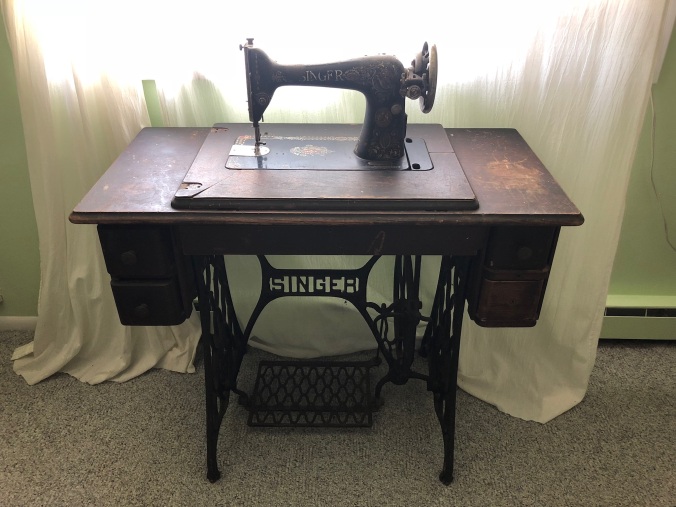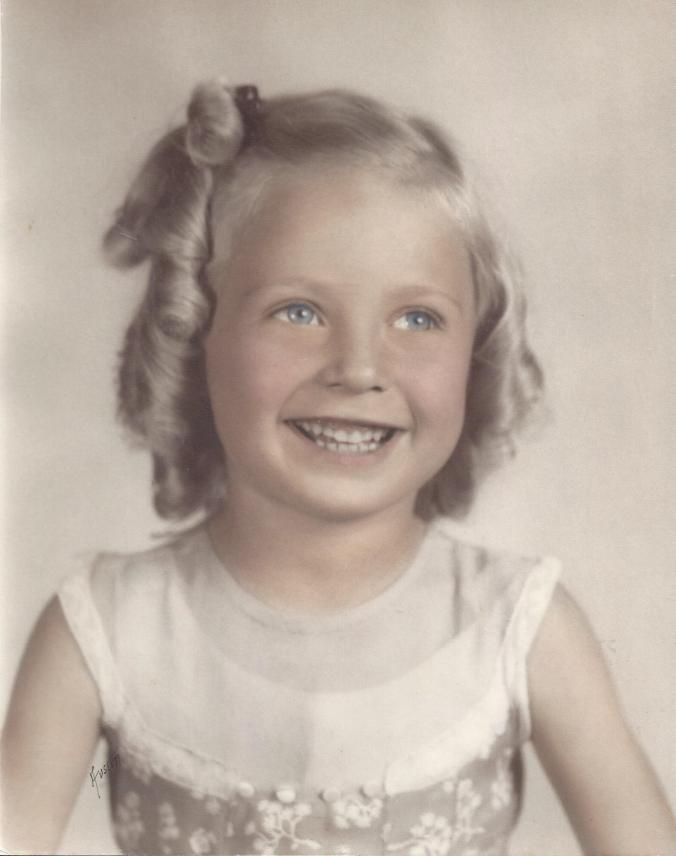
My mother’s old treadle sewing machine, now in my daughter Nina Renee’s upstairs bedroom.
It is late fall, the living room is dark except for the pool of golden light that shines on my mother’s hands as she guides the fabric for my new nightgown under the pressure foot of our old Singer sewing machine, the teeth of the feed-dog pulling the fabric as her feet work the treadle. The machine is set close to the floor furnace, and I am standing over it, the rising heat captured under my old nightgown, billowing out the skirt. This old gown is faded and a bit rough to my skin. The wringer washer and line-drying have taken a toll. I can hardly wait for Mom to finish. I want to put on the pretty flower-sprigged nightgown. I want to feel the soft flannel against my skin when I lie in bed, my feet tucked up inside the skirt.
I loved to watch Mom sew. I loved the sound of the treadle at night when I lay in bed waiting for sleep. The heavy old Singer lived in my parents’ bedroom, but on cold winter nights when dad was out late at the bars, which he was most nights during those years, Mom would roll the machine into the living room, place a floor lamp where it would light her work area, and sew, the sound of the treadle, a comforting sound that helped me sleep.
Mom’s first sewing project with the coming of cold weather was new flannel nightgowns for me and my little sister, Juanita. Those finished, she would begin her Christmas sewing. She would make sure that Nita and I were in bed then close the door between the living room and hall, telling us not open it. We didn’t object. We knew Mom was making presents for us. Most years it was intricately constructed wardrobes for the dolls that were almost an annual present, layettes with pin-tucked batiste dress for the rubber dolls we got the first Christmas after WWII when rubber could again be used for things like dolls; two-piece suits with pleated skirts, and matching double breasted jackets with notched collars and back-belted notched-collared coats, lingerie satin slips with snaps on the shoulders and beautiful lace for the hem. One year, though, Mom made the dolls as well—upside-down dolls with tiny waists and slender arms, embroidered faces and yarn hair, beautiful dresses with full skirts and tiny puffed sleeves. The dolls and doll clothes were all made exactly like well-tailored real clothes, real-people clothes in miniature. The dolls we got for Christmas were never expensive dolls, but the wardrobes Mom made for them put them in another class altogether from the dolls my friends got for Christmas. I was a critical child, but those doll clothes were never a disappointment. They were special. I could see and appreciate their quality.
Mom enjoyed working with fabric. She enjoyed the whole process—looking at patterns, choosing fabrics, envisioning what she wanted to create. I loved to watch her. I loved to see flat fabric take on wearable shape. I wanted to help, and Mom patiently taught me how to lay out patterns and pin them to the fabric. She showed me how to pin seams together and get the cut fabric ready for her to run through the machine. It was a long time, though, before I was big enough to work the treadle. Even when my legs got long enough, working the pedal was tricky, coordinating my feet while guiding the fabric even trickier. I was well into my teens before I got the hang of it.
I was big enough to sew by hand, though, and Mom taught me how to baste and hem. She also taught me how to embroider. We bought patterns at the dime store, and Mom showed me how to iron them onto fabric, usually flour sacks to be made into dishtowels. We started with cross-stitch, then moved on to running stitch, French knots and satin stitch—all the basic stitches. It was fun looking at the colored floss, choosing which to use. Mom would help me thread the needle. I would then position the hoop over the portion of the pattern where I wanted to start, and the image would begin to take life.
I loved school, but I also loved being at home working with Momma. She was a patient teacher and enjoyed working we me. We made cookies and cakes together. I helped her with the laundry. She showed me how to fold towels and washcloths, socks and underwear, how to dampen down the things that need to be ironed, roll them up tight and wrap a towel around the individual bundles to let the water penetrate the fabric. We had a built-in ironing board in the kitchen located close to the door to the living room, and on ironing days I would sit at the kitchen table and watch Mom iron. There was always a big roll of flat items—dishtowels and pillowcases and handkerchiefs. This was my ironing, done under her careful observation. It was fun to see the fabric become smooth and dry as I ran the hot iron over it, hot steam rising. I would fold each item as I finished it and stack it on the table, the whole kitchen perfumed by the smell of hot, clean ironing.
There was such a Zen-like quality to my mother, a gift for giving herself completely to whatever she was doing. I loved the feeling of peace and quiet when I was with her. I wanted to be like her. I wanted that same life when I grew up. I wanted to have my own home someday, my own children. Yes, I wanted to be a teacher, but I also wanted to be a full-time homemaker. I wanted both worlds—school and home. I didn’t feel the conflict between those two desires then. That came later, much later.
~

Mom made the dress I am wearing. It was made from material left over from a dress she made for herself. She loved doing detail work like the lace edging and pearl buttons. I am about five in this picture. This was probably my Easter dress that year.
Another enjoyable read, Loretta — your memory is phenomenal! Almost all of what you experienced with your mother’s sewing was true for me, including the sewing machine!
LikeLike
I remember that which impressed itself deeply, that which I’v held in memory, brought up periodically to relive and enjoy. Other things have receded; somethings I’ve completely forgotten.
LikeLike